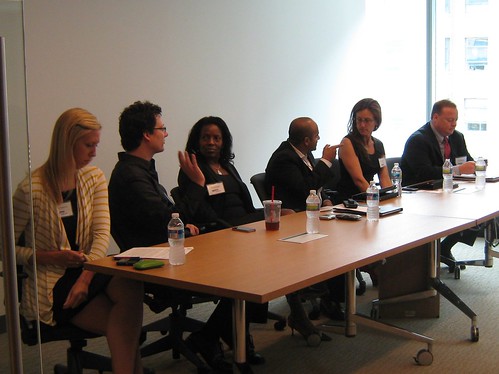“A crisis is an opportunity for contact with people. And social media is the ideal space for that contact,” explained Greg Kilhorn of Carousel30 at the WWPR event “Social Media and Crisis Communications.”
In an era where negative headlines hit the press at a faster rate than ever, the lunchtime panel discussed best practices for using social media during communications crises. Meeting on May 26 at Hager Sharp, the panel included:
Raj Aggarwal, President, PROVOC
Greg Kihlström, CEO, Carousel30
John Hellerman, Partner and Co-Founder, Hellerman Baretz Communications
Roz Lemieux, Partner, Fission Strategy
Derede McAlpin, Vice President, Levick Communications
Moderator: Rachel Henderson, Account Director, Public Affairs Group, Ogilvy PR

Social Media & Crisis Response
The panel agreed that social media can be a particularly useful tool during crisis scenarios, since it naturally allows for direct engagement with the customer. Hellerman emphasized that communications professionals should embrace tense discussions on social media during crisis situations. Ironically, playing host to such discussion allows the brand or company to retain a measure of control. Instead of conversations happening far away from the company’s watch, social media allows the brand to respond to criticisms directly, and set the record straight right there on the same page.
Lance Armstrong & Steroids
Henderson asked the panel how they would advice celebrity biker Lance Armstrong to use social media to address the allegations of steroid use. McAlpin applauded Armstrong for coming out and addressing the issue head on in a recent Tweet. She summed this advice up as: “Peel off the Band-Aid, deal with the pain, and then rebuild.”
Lemieux warned the room to pay close attention to the “voice” of their clients. She noted that while Armstrong generally Tweets in a very personal tone, his messages regarding the steroid accusations have had a far more “corporate” feel. An abrupt change in tone can raise suspicions about how authentic such messages are. She also encouraged the audience to consider the “good” side that can sometimes result from communications crises—since they can provide an opportunity or a company or brand to correct a wrong, or set the record straight.
Crises & Bloggers
The panel ended by discussing best practices for dealing with bloggers. The benefit of dealing with this community is that each individual speaks with their own distinct voice. This can be a double edged sword, since being attacked by a blogger can erode trust amongst the community that follows them. Yet this also offers a unique opportunity for communications professionals. By demonstrating to a blogger how your company has done the right thing in response to a crisis, you have the chance to shine a positive light on the situation, and turn the story around.



